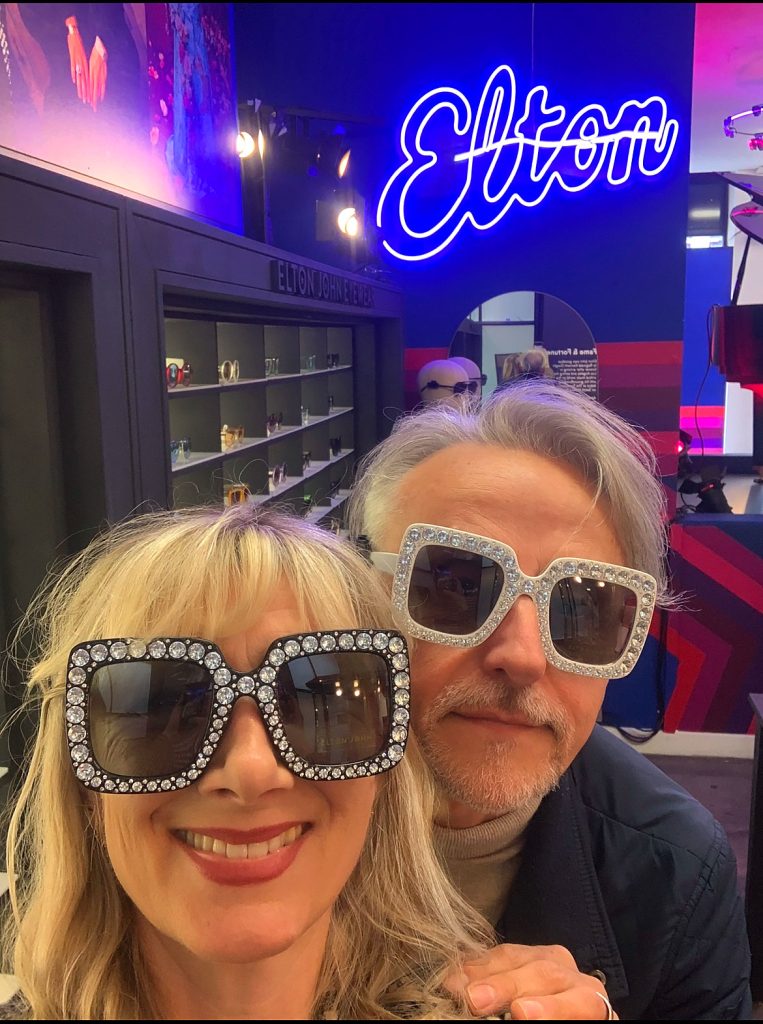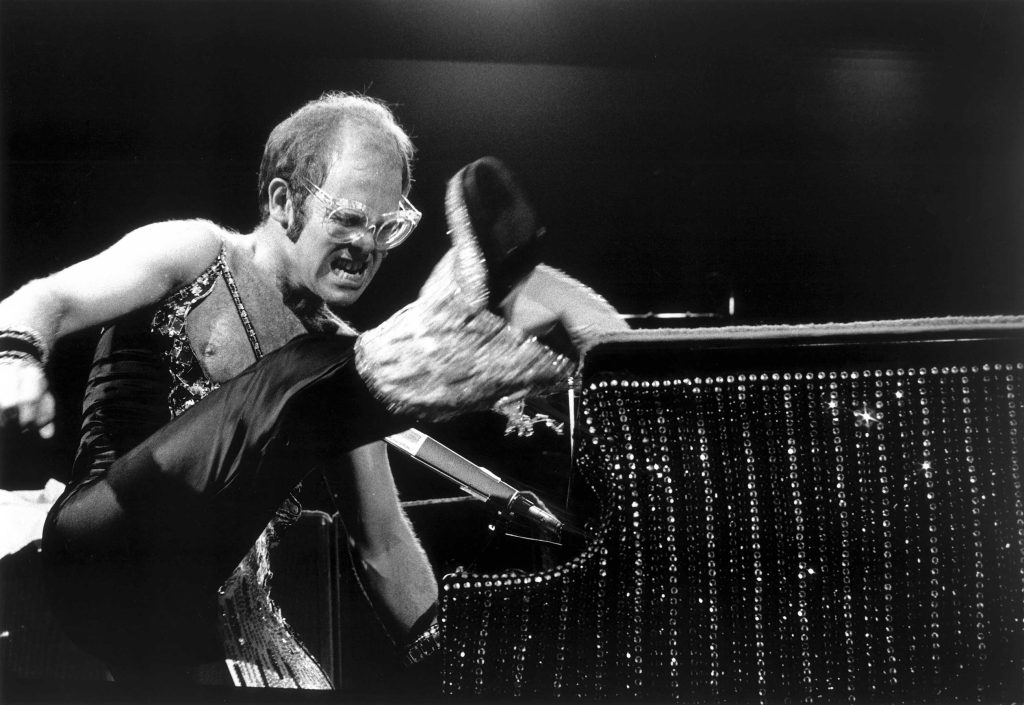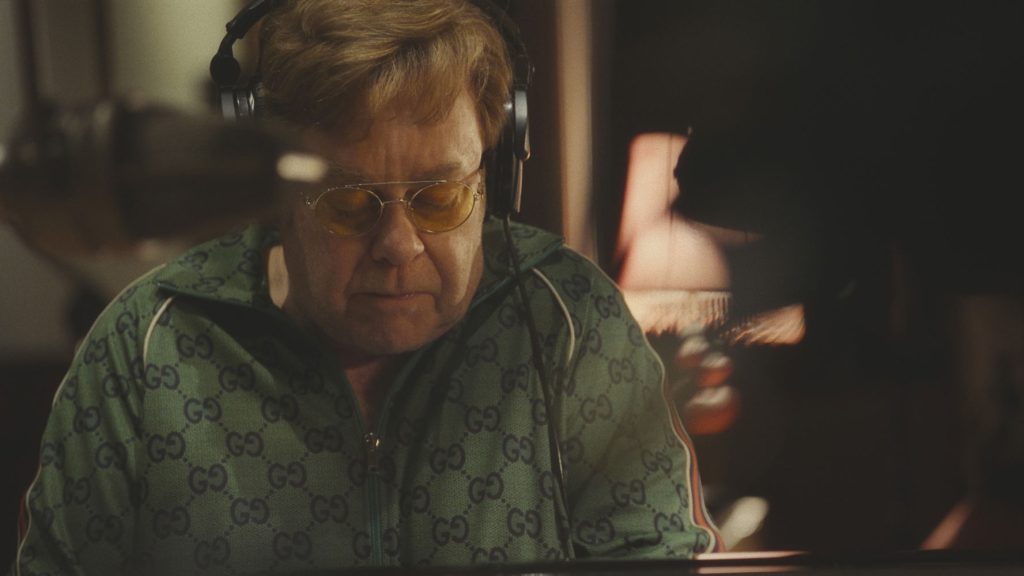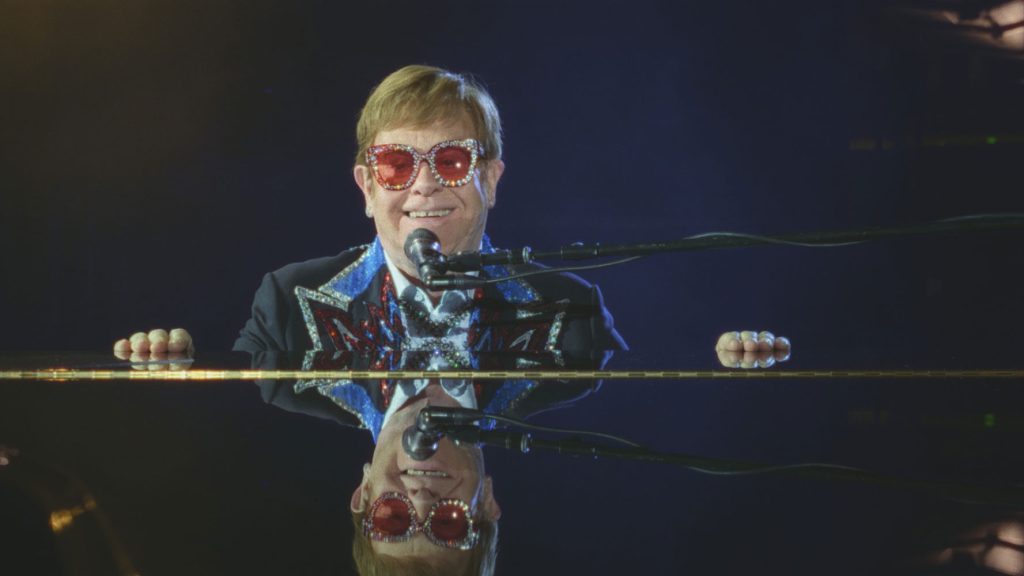Menu
‘Never Too Late’…A Discussion with the Archive Producers
EltonJohn.com’s John F. Higgins spoke with Kate and Mike Griffiths, the Archive Producers for Elton John: Never Too Late, about their work finding rare material for the documentary, available to stream on Disney+. John worked with the Griffiths on the documentary as Elton John’s Legacy Consultant.

Kate and Mike Griffiths at Elton's London pop-up shop in 2023.
EltonJohn.com: What was your role as Archive Producers of the documentary?
Kate Griffiths: The directors, R. J. Cutler and David Furnish, had a very specific vision – they wanted bookends, essentially, of Elton’s Farewell Tour and the 1970-to-’75 time period. The brief was, “Find us everything that Elton did in that five-year period.” And with that, there were clearly markers to look at. One was Russell Harty’s ITV Special for Dodger Stadium ’75. One of the first things they said was, “Can you find us any more from that, other than what was in the show itself?” The overall brief was, “Find us the unknown…find us the unseen.”
Mike Griffiths: With Elton in particular, because there is so much material that has been seen, that was a challenge. We were very fortunate to be given the time and space to do a deep trawl. You do a surface skim and you keep going deeper and deeper. So, there’s that five-year period that you’re focused on, but it’s still a massively broad canvas.
KG: We worked from July 2021 to Christmas 2023. And it took a lot of people that we spoke to, not least yourself, that helped to take us on leads and follow down places where we found things.
EJ.com: Did you submit everything you found to the directors? Or did you sort of make a pre-edit judgement call?
MG: Everything we found we put in front of them. And certainly, we sent them things that they initially considered but didn’t quite fit the narrative.
EJ.com: You found quite a bit of footage, and photographs, that had not been seen before…starting with the opening bit: Saturday Night’s Alright (For Fighting).
KG: Yeah, that’s Elton performing at Randwick Racecourse, Sydney, in 1974 which was shot for an ABC Australia program called GTK. That was a tricky sequence because we had to track down the physical film master, which was in the National Film and Sound Archive of Australia.
MG: We love the decision to have it as opening the film; I think it’s one of Elton’s most energetic, vibrant performances…just phenomenal. But, as happens often, the footage didn’t look good. And we couldn’t open the film with something that wasn’t great quality. We licensed that footage via an archive library called Reelin’ in the Years. David Peck, who runs that, is also a huge fan of Elton and was wonderful sending us so much stuff.
EJ.com: Did you look for out-takes from the Russell Harty 1975 documentary?
KG: Everyone’s seen that footage. It’s well-known. And we were like, “There must be more to it! Where are the rushes?” And we literally tracked down every single person who worked on it.
MG: Kate was tenacious on this: the cameramen, the editor, everyone in the credits.
KG: A lot of them had sadly passed away but the editor and one of the cameramen were still alive and they were able to verify that there wasn’t any more footage. Essentially what happened was, when Russell got the gig it was an exclusive to go and film Elton and people around Elton. They didn’t send a crew that would be used to filming a concert, instead they sent two news cameramen with limited film stock who brought back absolutely everything they shot and it all got used in the doc. There was nothing left over.
EJ.com: There’s a part where you see them piling into their limousines at the end of Dodger Stadium and driving away quickly…and the police motorcade has to catch up!
KG: Yeah, that’s really fantastic footage as well. The original documentary uses that but it’s under the end titles crawl. We were very fortunate that Elton had his own clean 16mm print of that, with no captions.
EJ.com: It looks like you had more joy when you explored the 1973 Bryan Forbes documentary material.
MG: Yeah. We had no idea what was there until it was all digitized!
KG: One of the first things we did, when we went into Elton’s archives, was ask [archives overseers] Adrian [Collee] and Laura [Croker] “Where’s the treasure?”
Both: And they said, “Have a look at this!!”
KG: Bryan had signed the copyright over to Elton and handed over 30 cans, I think, of film that he shot. There were 16 hours of rushes and outtakes from the Bryan Forbes 1973 documentary. It’s all beautifully shot and we had it scanned to 4K.The 1973 documentary is only around an hour long and the rest had never been transferred. Bryan shot everything on 16mm film negative with the audio recorded separately on Magnetic tape, which would then be synchronized in the edit. We had a bit of a jigsaw puzzle because all of the footage was mute so it was a case of listening to the audio and going, “What segment does that sound like? Okay, that could be that, so let’s try and sync that…” It wasn’t us who did this, it was the editors in in LA.
EJ.com: There is one scene, an outtake from the Forbes doc that broke my heart…“What’s your next ambition?”
MG: He’s got all the success and all of these, all of the trappings. And yet somehow he’s clearly so unhappy. It’s very touching, that.
KG: That was exactly the stuff that they wanted for the doc because it was actually behind the scenes. He was really miserable and that footage encapsulates it.

Elton onstage during his 1974 North American Tour (Sam Emerson)

Elton in the studio (photo courtesy of This Machine)
EJ.com: Another jaw-dropping thing that has not been seen before is the footage from Elton’s concert in Santa Monica in late 1970. It puts the viewer right there in the front row when Elton was starting to really go for it.
KG: That was a wonderful find from a brilliant LA archive called Retro Video – a clip from that concert had been shown on the Henry Mancini Show in 1970 (Elton’s debut on US Television).
MG: That’s so amazing. When we first saw that we were really hoping it would make the final cut.
EJ.com: There are some “home movies” Super 8 footage that one of Elton’s roadies shot during the ’71-’73 period. A real treasure trove. Were you able to get all the way back to the source material for that?
KG: Yeah, we did. This Machine Producer Ryan Gallagher was dealing with John Babcock’s stepson, Jack Toothman, on that. Thanks to him we were able to access the original 10 reels of 8mm film cans.
EJ.com: Was there a surprise location, separate from Elton’s Archives, where you found material?
KG: The Cliff Jahr audio tapes for Elton’s 1976 Rolling Stone interview, which Mike found.
MG: It was a little bit out of our timeline but R. J. was looking for archive illustrating Elton ‘coming out’. So we went and looked for it and managed to track it down to the New York Public Library (NYPL), where Cliff’s archives are held. Actually, we didn’t know if the tape still existed, or if it was in there. We had to dig a lot deeper, which Kate started to do. She built up a relationship with the archivist there and they were super helpful, in particular, Annemarie van Roessel.
KG: We couldn’t do our jobs without people like them. Cliff’s estate were also very supportive and wanted this to happen. They allowed the door to open and then we were working with the archivists at the NYPL. I engaged them and they understood the significance of this. And then, of course, when we heard it, and then when Ryan, R. J., and David and Elton heard it…it was like, this is so amazing! And on the audio tapes, you could hear a camera clicking, so we got in touch with Ron Pownall, who was the photographer in the room, and he gave us all these shots that haven’t been seen before.
EJ.com: Is part of the process, you’re looking for one thing and something else falls into your lap?
MG: Yeah. That happens quite a lot. You’re focused on finding something, but from some other tangent or some other alley that you’ve gone down in your research, you certainly find yourself going, “Wow, how did I get here?? This is amazing!” I often have to stop what I’m looking for because I found something else. I have to make a note, particularly if it’s online somewhere. Let me get that link sorted out straight away, or rip this now, so I’ve got a reference for it. With Elton material, you could do that forever, really.
EJ.com: This makes me think of the John Lennon footage. You knew that you had certain resources for that, but I assume that even up until the last moment, you were hoping that something pops out of somewhere.
MG: Absolutely.

Elton onstage during the Farewell Yellow Brick Road Tour (photo courtesy of This Machine)
KG: Yeah. Right up until lock-picture. The Madison Square Garden John Lennon sequence was very difficult to build. It wasn’t officially video recorded. That whole sequence is made up of many, many parts: audio, photographs (the team made wonderful animations out of some of the photographs), different bits of movies – all of the fan-shot Super 8 stuff: the Mary Ann Summers and the Enzo Centofanti films.
EJ.com: My first Elton concert was in November 1974 in Boston and, lo and behold, there is fan-shot footage of that!
KG: I think somebody contacted the production company (This Machine) in LA about that. They did a call-out on Elton’s socials and we had people get in touch with us saying they have this or that material…some of it unique. We had a guy that had filmed Dodger ‘75 and we were really excited about that, He said, “I’ve got a super 8…I filmed it all.” And then he could not find his film! He searched everywhere! He was devastated. But the Boston one landed in our lap, pretty much.
MG: You really get the sense with the stage set-up and the lighting and everything of what that concert was like…and that also ties into the John Lennon story. The last time John played a live concert was in 1966 and it’s moved on massively since then! I mean, you get the scale.
EJ.com: You had help from people in Elton’s inner-circle, like Tony King and Mike Hewitson.
KG: Absolutely. I have to say, “Thank you so much Mike Hewitson!” He is such a wonderful gentleman and we were very honored that he allowed us to record his memories. He also had that wonderful photograph of Elton and John Lennon in funny glasses that is in the film. They’re in that hotel room obviously having a good a good laugh – enjoying each other’s company. And of course it was Tony King who brought them [Elton and Lennon] together. Tony King is also a huge “Thank you.” We interviewed him for the documentary and he helped very much with that period of time when John and Elton met.
EJ.com: I’m loving the footage of Elton meeting John.
KG: The Mind Games commercial shoot, yeah. That’s such great footage, capturing the moment Elton first meets John in real life! And Tony is so funny dressed up as the Queen! Huge thanks go to John McEwen for supplying that clip to us and to Yoko Ono for approving its use.
EJ.com: It’s just so bizarre to think of Elton hiding in a corner with the polaroid camera…
KG: He is fanboying!
EJ.com: How did Elton’s diaries come to light?
MG: Those are just insane!
KG: We didn’t find the diaries. I think they had been in a suitcase in an attic, forgotten. And I think it was whilst David was searching for other things … I think the conversation was R.J. saying to David, “Obviously, Elton keeps diaries. Has he got his diaries from back in the day?” And David going, well, let me see. David spent some time locating them.
MG: That was a really personal thing to hand over. What an archive resource.
KG: We stand on the shoulders of a lot of people that went before us, and did all of this research. We have to thank Keith Hayward for all his guidance and information. Ray Williams, who was just so phenomenal and helpful in sharing information with us that allowed us to follow threads of possible archive sources. Henry Scott-Irvine, Adrian Collee and his son Joe. And lovely Laura Croker. We also have to give a shout-out to the Elton John Rocket Club, because I was there looking at comments and posts. We bow down to the fans for knowing much, much more than we ever will. It was a steep learning curve for us. Even though we thought we knew Elton, we certainly didn’t know Elton as well as you guys do.
